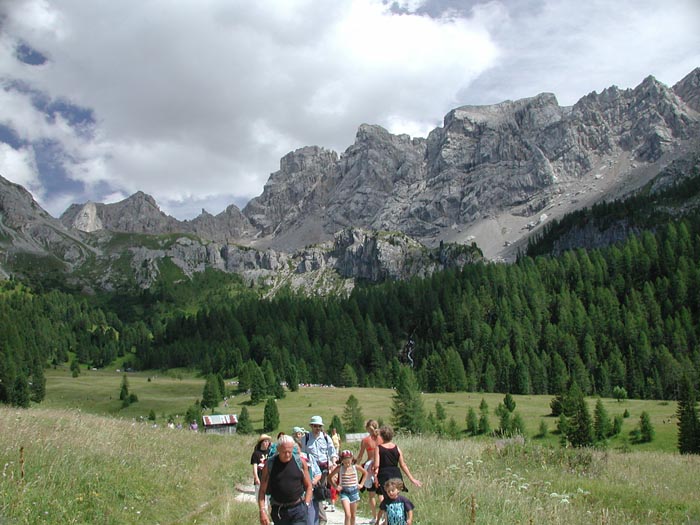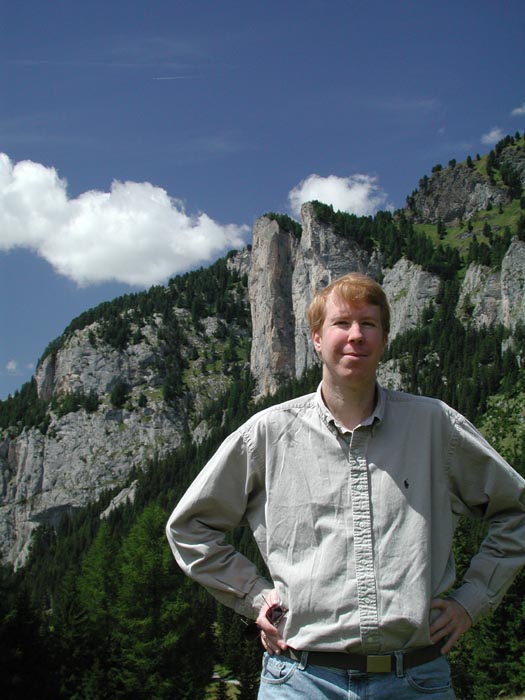“The Abyss”
March 26, 2003“The Firebomber”
July 26, 2003“The Cows” (July 2003)

Ok so in this area of Italy (the Dolomites, an area of huge stone mountains surrounding grassy green valleys with little villages in them… villages where they sometimes wash their clothes in concrete troughs in the village square, and eat and drink VERY well) they sometimes get into their cars (Volkswagen or similar) and drive to a parking lot to park their car for the afternoon, and from there hike a few miles up the trails through the forests and fields to a rolling green field or pasture to listen to live music for the afternoon (jazz or classical is common). Trees are scattered around for shade, and a little wooden building serves as a restaraunt for wine, spaghetti, or whatever you like. In this part of Italy, at an elevation of about 6,000 feet (marked for reference over the door to the restaraunt), the air is always cool and dry and clean and perfect. The band had wrapped up and Sergio was talking with some Italian friends so I set out along a trail that seemed to lead to the top of a ridge a few miles distant… it looked like maybe 2,000 feet vertically and 2 miles horizontally that I needed to cover, starting from 6,000 feet and working up to 8,000. This ridge of the dolomites strung between two towering peaks, with a trail zig-zagging back and forth, working it’s way to the crest. At first, the hike seemed pretty feasible, and after about 30 minutes or so I was some fraction of the way there, but still nowhere near the top… then I saw a few tiny specks creping along the trail near the crest of the ridge. Dogs? No. People. Crap. That crest was a lot farther away than it looked… two or three people crept along it like ants, maybe a half a mile or a mile away and equally far up the 45 degree slope of the moutain. This was going to be a lot harder than I thought. No matter, I can still finish it. So up I continued, at a much slower pace than walking on level terrain at sea level and here is why: Walking involves about 3 levels of energy transfer: First, your fat reserve must be burned off for energy, like fuel from the tanks. Then, the raw energy must be used with oxygen that is absorbed by your lungs and distributed by your heart. Thirdly, your muscles must use this energy to get you moving. In theory, this 3-step process will be perfectly optimized: You will eat just enough to have just enough fat to carry you the distance, and your cardio system will be maxed out putting out energy just exactly as fast as your muscles can absorb it and turn it into motion. In other words, the fuel tank will be just the right size for the trip, the fuel pumps will be just the right size to run full speed and feed the engine while the engine is running full throttle, and all systems will be running at 100%, burning off your last gram of unwanted fat JUST as you arrive at a restaraunt for a refill and a glass of red. All in perfect balance. An optimized system. Vino Rossi pere favori.
Of course, we do not quite live in this optimized world. When you sit around programming computers all day, you have an excess of fat on board (that you still have to carry… like loading up with a huge amount of extra fuel that you are never going to burn… it just weighs you down) and when you live in South Carolina (elevation: 200 feet) your heart and lungs can take it pretty easy, since there is thick, dense air rife with oxygen… very little work for the lungs to take oxygen in and very little work for yourt heart to move it to the muscles.
Which means that when you are climbing a hill in Italy at 7,000 feet, you become very aware that your system was not optimized for this flight condition. My muscles were pretty happy with the workload, but were only running at maybe 30%. Why? My heart and lungs were not used to this thin air, and could not take oxygen from the air fast enough to feed the muscles. And the extra 20 pounds or so of fat didn’t help much either, since I was working up a hill. Too much fuel on board, adequate engine, totally inadequate fuel pump to feed it. This meant I had to walk a few steps, wait. Walk a few steps, wait. To do otherwise would put me into breathless overload, with questionable consequences as my heart raced, alone on a mountain ridge.
Thirty minutes later, the ants on the ridge that were actually people passed me on their way down as I worked up.
Thirty minutes after that, the top of the trail was in immediate view, and what lay on the other side of the ridge was…???
Well, I finally made it to the ridge, through a little gate that someone had put there, and saw what was on the other side: A HUGE GRASS VALLEY, LIKE A GRASS BOWL 3 MILES ACROSS AND ALMOST A MILE DEEP, surrounded by mountains on all sides but one, which fell away to an even deeper valley, followed by huge towering mountains beyond. It was totally unlike anything I had ever seen. A bunch of little white dots moved slightly at the bottom of the bowl… COWS! And wait, the sounds of a undred church bells all ringing at once! A ringing in my ears? Someone listening to churchbells on a stereo somewhere? A hundred churches? NO! They were the cowbells on all the cows! A hundred cows meandered lazily around the valley enjoying the grass, and each one had a bell, sending out a pleasant ringing that could be heard from miles away in the enclosed valley which acted as a giant ampitheatre! The melody of the milk was incredibly pleasant, like many churches all playing their bells at once. But why the constant ringing? Shouldn’t it stop when the cows stopped walking? No! The bells hung such that the motion of the cow lazily chewing the grass would keep them ringing, even if the cow was not actually walking, so the whole valley was filled with the dance of the dairy as the cows lazily munched away at the fresh grass. This cacaphony of the cows continued, evenly, all day, every day. The musical undulation of the udder was not just to sound nice, though… I finally saw how the farmer could use the audible beat of the bovines to track down any cow that wandered out of the recommended munching area. The vibration of the Vitamin-D sure did sound nice, though! I later learned that Sergio worked at this pasture many years ago, using a cythe to manually cut the grass (“The cows preferre the short, fresh grass.. the long grass is dry, and exposed to the sun for too long”) and storing the cut grass to use as a bed (“Wonderful! So natural. So nice”) and milking the cows when needed (“Just cutting the grass and milking the cows… it was perfect!”). I also later learned that this region of Italy does not import milk, but instead uses the output of these cows for local consumption. I don’t know how you can tell what grass a cow preferres, but anyway, there you have it. I think I could tell the cows were very happy, wandering around the idyllic pasture, eating fresh grass, with the sounds of a hundred churchbells all day. Much less stressful than doing customer support for X-Plane.
Anyway, at the crest of the ridge, the trail made a T-intersection: one that led to the farmhouse where the bovines handed over their milk in return for the humans cutting the grass for them, and the other way along the rim of the bowl to some strange towering rock formations. Walking along the rim of the bowl you had to be careful not too lose your balance… the slope was about 60 degrees near the top, and a fall would be pretty hazardous until the terrain leveled out into the pasture… but that would involve tumbling hundreds of yards until the terrain smoothed out, and I got the impression the cows would not be much help to me if I fell. They could offer milk, and some music, but that’s about it. Sergio later told me they are very pacifistic… they lounge aorund and let you pet them, and if you move towards them too quickly they get scared and run away… they do not know that they are bigger than us!
As the towering rock formation got closer, I could see that some of the rocks were strangely regular… man made! Someone had built a little room into the natural rocks.. how long ago? Whoever it was, they used rough-hewn stones carved from lcoal rock, and some sort of rough “concrete” of local bits of rock. There are many castles in this area of the world, and they are all built into the most innaccessible places (into the sides of cliffs, on top of pillars of rock, on huge rock outcroppings) to make them as innaccessible as possible to invaders. So I suppose that perhaps this rock wall was a home built hundreds of years before, carved into this innaccessible area to protect from detection and invasion. You had to be careful where you walked though so as not to fall.
Well, enough time had passed and Sergio and his friends would be waiting, so back along the trail, a last listen to the contralto of the cottage cheese, and it was back down the trail from the ridge. The music disappeared entirely the very second my ears descened below the level of the ridge.
